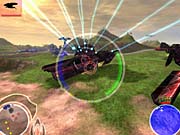Battle Engine Aquila is a futuristic mission-based shooter that puts you at the controls of a spiderlike tank that can transform into a jet for short periods of time. The game doesn't stray too far from the standard mission-based action script, but it does give fans of the genre something new to try, though many will surely feel as though they've played this game before.

The story in Battle Engine Aquila casts you as a futuristic forklift driver named Hawk. As luck would have it, the Forseti military has been developing a new combat craft that pilots similarly to what Hawk is used to driving, and some treachery forces the Forseti to look to Hawk to pilot the Aquila against the evil forces of the Muspell. All of this takes place on a planet with melting polar ice caps, meaning each level has more than its fair share of Aquila-killing water. The story is told via pre- and postmission cutscenes.
The game sets up each mission with a cutscene and a brief paragraph or two of text that details your upcoming tasks. You'll also receive radio transmissions while in the cockpit of the Aquila, which give you updates on the battle's current status. Most of the game's missions put you in defensive mode, asking you to guard transports or nearby buildings while eliminating nearby foes. Each mission has multiple objectives, however. Completing primary objectives is enough to move the story forward, but completing your secondary objectives will branch you over to different missions. Usually, the branched missions are pretty similar to their main counterpart, but there are a few drastic differences later in the game.
The Aquila has two modes, and you can transform between them whenever you like. The walker mode is a sort of spiderlike tank. You can stomp and strafe around the landscape, circling tanks or buildings and quickly sidestepping out of the path of incoming missiles. The jet mode, as you might expect, lets you take to the air and fly around like a plane. Jet mode takes up energy, though, so you can only fly around for a little while before having to land to recharge your energy, which is done by simply being in walker mode. In addition to your energy, you also have a life meter to worry about. Each form of the Aquila has its own weapon set, and you can gain access to alternate Aquila weapon loadouts as you play the game. The weapons are pretty simple and include ammo-chewing machine guns, rockets, and a large, chargeable beam weapon that acts a bit like the PPC from MechAssault or other BattleTech games. In many cases, the game will take all the challenge out of aiming. The Vulcan cannon automatically tracks and leads your target, while most of the projectile weapons are either easy to point or have an automatic lock-on feature.
The game's multiplayer mode lets you select a battle engine configuration and dive into three types of two-player matches. Co-op pits both players against a variety of Muspell forces. Skirmish mode gives each player a base, which is defended by turrets and tanks. The object is to eliminate the enemy forces. Finally, there is a one-on-one mode for going directly up against another battle engine. More maps are unlocked via the single-player game, as are a ton of concept art and other little tidbits.

Graphically, Battle Engine Aquila has a pretty standard look to it. The gameplay doesn't slow down, and overall the game looks pretty nice without really standing out. The only notable weapon effect is the upgraded version of your main cannon, which can white-out the entire screen when it lands, but even this isn't especially impressive.
The game's sound is similarly stock-feeling. The voice work contains a lot of English accents and is solid without going over the top. The voices inflect well, and the game's sound effects and music give the same sort of general sci-fi feeling as the rest of the game.
Battle Engine Aquila is a fair addition to the mission-based sci-fi sim genre. It meets the standards of the genre without really breaking any new ground. The branching mission paths are a nice idea, but in practice they could have allowed for more mission variety than the final product actually has. Fans of the genre will be able to dig around and find some things to like, but in the end, Battle Engine Aquila is better suited for your rental list than your purchase list.